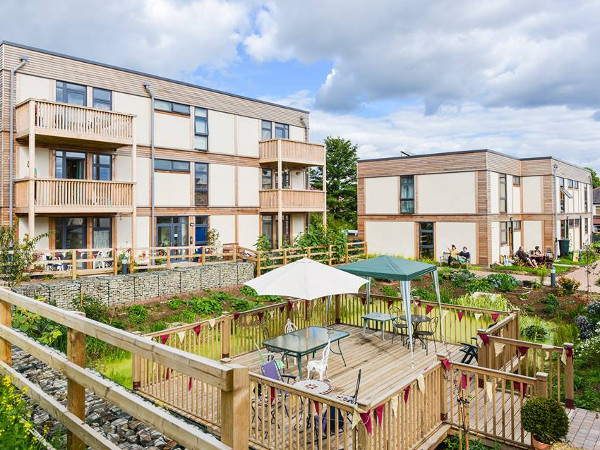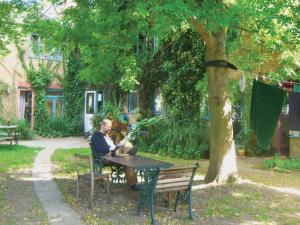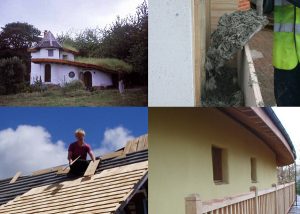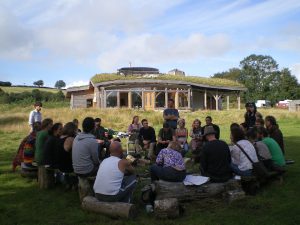Cohousing - introduction

“the very process of living together educates. It enlarges and enlightens experience; it stimulates and enriches imagination” – John Dewey
Contents
What is cohousing?
Cohousing is a type of intentional community where individuals, couples and families come together to share common goals, plus the workload and benefits of living closely with others – but at the same time, those individuals, couples and families have their own self-contained accommodation. In other words, it’s a community of private homes clustered around shared social spaces. Each home will have all the traditional amenities and privacy, including bathroom and kitchen, whilst shared spaces typically include things like gardens, laundry, workshops, gym, kids play area, guest rooms, parking, shared social / hanging out areas and maybe a shared kitchen and dining area.
Cohousing projects can be set up using a range of legal / ownership structures, depending on the needs of the people involved – from completely co-operative to completely private. Members may own or rent their private spaces, or own shares in the entire property. It’s the architecture that’s important in cohousing – so that the layout of private homes and shared areas encourage a sense of community. Economically, each household is separate (although there may be shared businesses / enterprises / projects). Decisions about issues that affect the whole project are made by members non-hierarchically, and often by consensus. Note that housing co-ops are not necessarily cohousing – often, co-ops own properties that are spread around a town, not situated together where they can share facilities; and ‘intentional communities’ may not fit the usual description of cohousing either, as they may not have separate, private kitchens or bathrooms.

Communal meals (and other activities) are regular or ad hoc occasions where everyone gets together, not usually an everyday occurrence. There may be shared projects, such as food production, maintenance, splitting firewood, renewable energy installation etc. These projects could be carried out by members or by outside contractors. There may be voluntary hours required of members, or not – it depends on what the members decide together.
Cohousing projects can be intergenerational, or for a particular age or type of person (there are many ‘senior cohousing’ projects, for example). They could be seen as a move towards the kinds of extended families that have been lost – but ‘families’ of people that we choose to live with, rather than blood relatives.
Schemes can be government- or housing association-led, architect/developer-led or community/people-led. The first two types are top-down, the third, ‘grassroots’ or bottom-up. Architect/developer-led projects (more prevalent in North America than in Europe), while better in terms of sustainability and community than typical commercial developments, can often end up relatively expensive.

History
Many traditional villages all over the world operate in the same way as cohousing projects, without labelling themselves as such. As a modern concept, in which people deliberately move to this kind of life (rather than away from it, as has usually been the case), it all started in Denmark in the 1960s. From there it spread to the US and back to Europe – particularly Sweden, the Netherlands and the UK, and more recently, to France, Germany and Spain.
In Europe, projects range from 6 to 80 households, with the majority between 15-30. Some are housed in high-rise blocks, with professional services provided to members. In Scandinavia there is talk now of clusters of several cohousing groups forming a wider community. Springhill Cohousing in Stroud is the first new-build cohousing project in the UK.
What are the benefits of cohousing?
- Community: we’re losing community quickly. It’s said that it takes a village to raise a child, but it also takes a village (even if it’s an urban ‘village’) to support an adult – especially an older adult, many of whom experience loneliness and find it difficult to carry out everyday tasks. Sharing housing also means that more housing can be freed up for other people.
- Support: people living in cohousing projects will tell you that the biggest benefit is mutual support. In times of ill-health, old age, bereavement, financial disaster, or with a new baby – cohousing can provide support, advice and assistance in ways that have long been lost in mainstream Western society. ‘Senior’ cohousing projects are common, where older people don’t want to lose independence, but they don’t want to be confined to the home, feeling lonely either. Older people in cohousing won’t be lonely, and can even share carers. This can reduce the need for local-authority-provided services.
- Security: there are plenty of people to look out for your place and your property. Maybe it could become the norm to leave front doors unlocked again. They’re also safe places for kids – with car-free play areas and oversight by lots of adults.

- Affordability: cohousing can be more affordable than conventional housing because units tend to be smaller due to the shared facilities, which themselves remove the need for every household to purchase / own a washing machine, lawn mower, power tools or car (for example), plus many other easily-shared resources. Plus cohousing lends itself to bulk purchases of perishable and non-perishable foodstuffs and other products; and also swapping (books, clothes etc.) and hand-me-downs (baby clothes and toys etc.). It can also be much more affordable if it’s a new-build project, and you provide the labour for the build yourself.
- Skills: cohousing enables skill-sharing, and promotes grassroots governance skills that can be used in other aspects of community-building.
However, cohousing projects tend not to be as radical as some co-operative housing ventures, such as intentional communities or registered housing co-ops. This has its upside, in that it can help to make collaborative living more mainstream, but the downside is that over time, the size of units can creep up, and consumption levels can reach, or surpass, national averages, despite sharing. Then cohousing can become an exclusive retreat for the wealthy, and increase gentrification. This doesn’t have to be the case of course, and in most cases it isn’t; and as a resurgence in council housing isn’t looking likely, and doesn’t involve much sharing anyway, and facilities such as shops and pubs are disappearing from council and ex-council estates, cohousing schemes seem to be the way to strengthen local communities.

Environmental
- Because of the shared areas, private accommodation can be downsized, saving on cost, resources and waste. Sharing allows downshifting.
- It’s often much easier in a group to grow food / keep chickens / compost waste / install renewables etc., and to pass on those skills. People are much likely to do those kinds of things when encouraged by others than if they were living alone. Also, sharing resources means that fewer of those resources need to be manufactured, reducing resource and energy use.
- Less fossil fuel needs to be burnt driving around for social engagements – whether they’re dinner parties, kids’ play days or just meeting a friend for a coffee.
What can I do?
First, read everything you can and talk with people who’ve done it. Start with the UK Cohousing Network, and see ‘resources’ for our links and books pages. See if you can visit existing schemes – some have open days and events. You have to work out if cohousing is for you, before you jump in. Remember that some decisions that you’ve previously made alone will have to be made with other people – are you OK with that?
Joining an existing or forming project
This cuts out a lot of work. The easiest way to find a project to join in the UK is via the UK Cohousing Network. There you’ll find lists of cohousing projects, some of which are forming and looking for additional people, and some of which are established projects that have room for new members. Their site also has lots more information and advice. Remember that an existing project will already have its own rules and procedures – so whether buying in or renting, make sure you read all contracts and leases carefully, especially any clauses on your obligations, decision-making and how to leave, if and when the time comes. Make sure you meet and get to know the members, as you’ll be sharing lots of aspects of your life with them.
Elsewhere in the world, you could look on the sites of the Global Ecovillage Network (GEN) or the Fellowship for Intentional Community.

Starting a project
First get some like-minded people together. You’ll be buying an existing property (or properties) or land for a new-build project, and unless you’re very wealthy, you’ll need a group of people to pool resources. If it’s a new-build project, expect it to dominate your life for a few years.
It may be an idea to initially start with a smaller group of 4-6 people, so that you can decide what you all want in terms of geographical location, shared facilities, cost, ownership / legal structure, lifestyle etc., and then invite more people to join the group once you know more about what kind of project it might be. These details may be much more difficult to hammer out with a larger initial group.
Legal / ownership options
There are many potential ownership options for a cohousing project – complicated because of the combination of communal and private spaces (models include community land trusts, other trusts, co-ops, limited companies, companies limited by guarantee, mutual home ownership society, commonhold, community benefit society, community interest company or combinations of these). Some may require the services of a solicitor, and some may have off-the-shelf models.
A common structure for a cohousing project is that of an incorporated body holding the freehold, with members purchasing a lease from it. Members can secure a mortgage (with a building society of course) against that lease. The lease may contain clauses restricting behaviour, and a company veto over future sale of the lease; these clauses may affect the value of the member’s unit, and should be discussed with the lender. Members could also rent their homes, or own shares in the company, rather than their own home. Cohousing is an umbrella term, with lots of different ways of organising.

Something to think about is that when members own their own home, things could become difficult when selling – if other members don’t approve of the potential purchaser. A lot of work might already have been done to get to that point, and it could create bad feelings.
Other things to consider are:
- Does any increase in value of the property accrue to individual members or to the community / organisation? (If one of the ideals of the group is the perpetuation of the community, then maybe the latter is the better option).
- Will your legal model provide the security for the community and/or members to purchase property / receive loans? (If individuals are able to do so, it will have implications for the increase in value accruing to the community, unless the organisation arranges loans and then offers loans to members).
- Communal areas and equipment etc. have to be provided, maintained and replaced – the money to do this has to ultimately come from members.
- The model has to allow for new members, in terms of rights and responsibilites, and the approval of new members by existing members (if this doesn’t happen, there may well be conflict in future, as members have very different understandings of how the community is to operate).
There are many more things to consider, and we’ll be interviewing people and blogging more about different ownership options, to drill down into the benefits and disadvantages of each.
Planning
In the UK, any site on which you might get planning permission (i.e. that is inside the development zone), that has room for several self-build homes plus shared outdoor and indoor areas is likely to be snapped up by developers very quickly. They’ll probably want to put more houses (or flats) on the site than you want to, and therefore the land will be more valuable for them, and they will almost definitely outbid you.
It’s not impossible – it’s been done in Stroud and Lancaster – but it’s much more difficult. You might be able to get permission to build outside the development zone, if you persuade the local authority that your project will provide affordable housing, community cohesion and social care in perpetuity – in which case you won’t be in competition with developers.
You might be looking at existing neighbouring properties, or one large building, or a property with outbuildings that can be converted to housing. This may be a farm, with several acres that you might want to farm yourselves – but if you don’t, you could rent to a local farmer (with the stipulation that they farm organically). You could also look overseas.

Rules
Before you start, you’ll have to work out rules around things like joining and leaving, maintenance, jobs, vehicles, shared access, sharing, fees, obligations etc. There may also be rules concerning consumption and its environmental impacts – for example, it makes no sense to share a laundry room if members have their own washing machines too. These rules have to be finalised and agreed beforehand, to avoid confilcts further down the line. The rules are made by the members themselves, not imposed by anyone else – it’s not some sort of ‘tyranny’, which is more likely to lie in not having rules at all. Once agreed, peer pressure is usually enough to ensure that they are observed.
Specialist(s)
Thanks to Martin Prosser and Monica King of Bridport Cohousing for information.
The specialist(s) below will respond to queries on this topic. Please comment in the box at the bottom of the page.

Martin Prosser is a founder member of Sunflower Cohousing. Having undertaken extensive studies and visited various cohousing options in the UK and Spain, his group decided to buy a site in France. Martin is keen to reduce his impact on the environment, and has built solar hot water, solar electric, composting toilets and an aquaponics systems, and is currently working on greywater recycling involving a natural pool.

Peter Burke is a director of A Fairer Society. According to Peter, “My purpose is sustainable development projects. How to create a proposition and a model that investors will trust and invest in. Especially for community-led / asset-backed projects, with my main focus on housing. My passion is designing a feasible plan with social, financial &/or environmental purpose.”










2 Comments
Spring Working Party – Sunflower Cohousing’s first Working Party of 2019
Sunflower Cohousing’s first working party – the ‘Spring Working Party’ will be held from Tuesday April 23rd to Tuesday April 30th, 2019, although we expect that visitors may wish to travel on the Saturday beforehand, and we will be organising activities for both Sunday and Monday.
We have 2 themes planned for this working party – Seedfest (back by popular demand) and preparing the storage/hayloft ready for the creation of new facilities for the community.
Seedfest is a must for anyone with a passion for growing their own food or gardening in general, or for anyone who would like to learn about growing fruit and veg from seed. There will be lots of sowing, transplanting, nurturing and pruning, plus some weeding, digging and mowing. The efforts during this week will hopefully keep everyone who lives and visits Sunflower Cohousing supplied with healthy organic fruit and veg throughout the year – weather permitting of course!
One of the building projects we will be starting this year is the conversion of the storage/hayloft barn into a community workshop with an apartment above – the apartment is intended to be available for rent to those who might be interested in joining our community, but do not have the capital available to become investing members.
These works will involve the dismantling of the overhang behind the workshop barn, and the dismantling and clearing of the hayloft and feeding troughs. Plus the recycling of all of the materials released, either in storage areas around the site for reuse in other projects, or at the local recycling facility. So if you would like to be part of a dismantling and labouring team, or have labouring skills you would like to offer, this is for you.
Accommodation for the working party is in tents set up in our arboretum area. Communal meals are provided (let us know if you are interested in helping with the cooking). There will be the opportunity in the evenings for camp fires, games and relaxing.
If you are interested in joining us for our Spring Working Party, please contact Maria for further details.
Considering Cohousing on Facebook.
Not your standard information but an essential read for anyone considering joining or already a member. This looks behind the usual claims about cohousing, based on detailed research and years of personal experience. Questions you need to ask, and analysis of patterns across many communities. Regular updates. Check it out.
http://www.facebook.com/Considering-Cohousing-2357455264501206